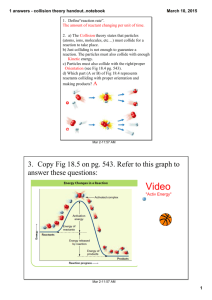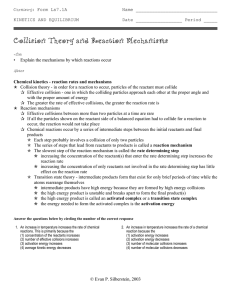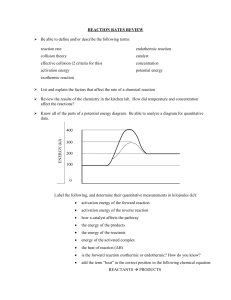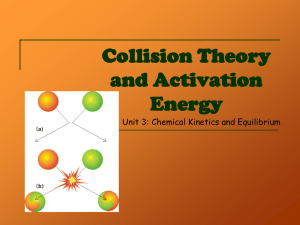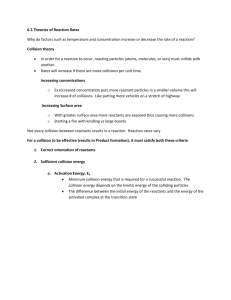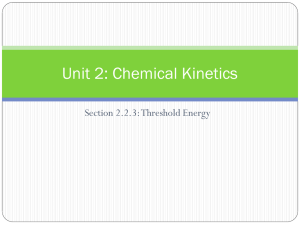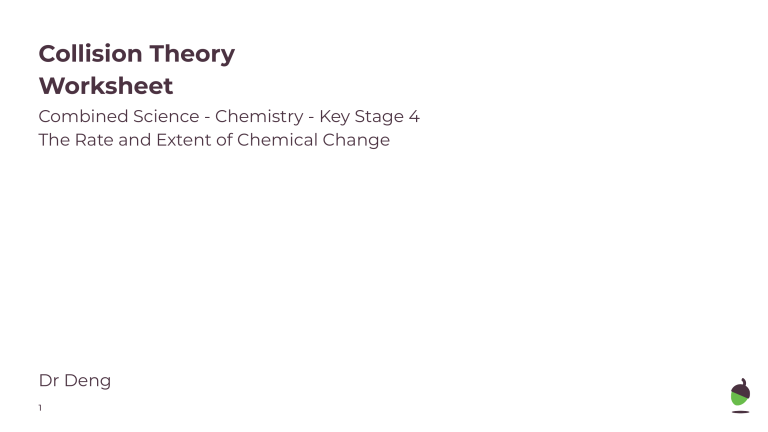
Collision Theory Worksheet Combined Science - Chemistry - Key Stage 4 The Rate and Extent of Chemical Change Dr Deng Which of the following is a unit for rate? m/s g/cm3 Option 3 Option 4 cm3/s cm3/g Collision theory states that for a reaction to take place, reacting atoms must... Rearrange themselves Form new products Option 3 Option 4 Break bonds Collide with enough energy What is the minimum amount of energy required for successful collision? Active energy Collision energy Option 3 Option 4 Activation energy Reaction energy The rate of reaction depends on two factors, they are... How frequently particles collide How frequently particles collide and the energy with which they and the time taken collide Option 3 Option 4 The energy particles collide with The energy particles collide with and the time taken and the number of particle involved In which of the following reaction profile diagrams is activation energy labelled correctly? Activation energy Activation energy Activation energy Activation energy Multiple Choice Question Answers Which of the following is a unit for rate? Option 3 cm3/s Collision theory states that for a reaction to take place, reacting atoms must... Option 4 Collide with enough energy What is the minimum amount of energy required for successful collision? Option 3 Activation energy The rate of reaction depends on two factors, they are... How frequently particles collide and the energy with which they collide In which of the following reaction profile diagrams is activation energy labelled correctly? Activation energy Independent Practice 1. What is collision theory? 2. Define activation energy. 3. State the 5 factors affecting rate of reaction. 4. Explain why rate of reaction increases when concentration of reactants in a solution increases. 5. Explain why rate of reaction increases when the size of solid reactants are in powder form instead of in large lumps. 6. Explain why rate of reaction decreases when pressure of reacting gases decreases. 7. Explain how temperature affects the rate of reaction. Independent Practice Answers 1. What is collision theory? For a chemical reaction to occur, the reacting particles must collide with enough energy. 2. Define activation energy. Activation energy is the minimum amount of energy needed for a collision to be successful. 3. 5 factors affecting rate of reaction: ●the concentrations of reactants in solution ● the pressure of reacting gases ● the surface area of solid reactants ● the temperature ● the presence of catalysts Independent Practice Answers continue 4. Explain why rate of reaction increases when concentration of reactants in a solution increases. There are more reacting particles per unit volume. Particles collide more frequently, rate of reaction increases. 5. Explain why rate of reaction increases when the size of solid reactants are in powder form instead of in large lumps. The smaller the size of solid reactants, the larger the surface area to volume ratio. Particles collide more frequently, rate of reaction increases. 6. Explain why rate of reaction decreases when pressure of reacting gases decreases. The lower the gas pressure, the larger the volume, the further apart reacting particles are. Particles collide less frequently, rate of reaction decreases. 7. Explain how temperature affects the rate of reaction. The higher the temperature, the more kinetic energy reacting particles gain. Particles collide more frequently, rate of reaction increases.
